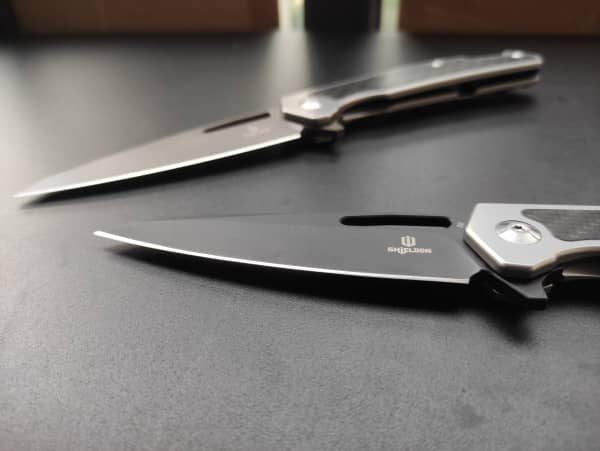If you’re just getting started in the world of knives, you’ve definitely come across several terminologies that didn’t make much sense. Knife enthusiasts have created their own language to express their passion for blades.
We’ve prepared a glossary of the most frequently used terms related to Taschenmesser to help you better grasp what people mean when they use them. If you read till the conclusion, you could learn some new words for knives.
Pocket Knife Terms
The following are some of the more prevalent terms used by knife lovers when characterizing the primary characteristics and capabilities of a certain pocket knife.
Back
This refers to the unsharpened side of the blade. When the user is tackling a challenging endeavor, this is never present only for the sake of appearance; rather, it serves the primary function of acting as an anchoring point for the user.
Bail
Some knives have a shape on the end of the blade that resembles a half loop. This is known as bail, and it allows the user to tie or clip anything to the knife while carrying it to prevent it from falling by mistake.
Belly
This is the curved portion of a pocket knife blade. On either side, it might be concave, convex, or a mix of the two. The size and shape of the belly of a knife blade typically dictate its effectiveness.
Blade Bevel
This is a fairly common word that refers to the piece of the blade that has been ground away to form the cutting edge of the blade. It normally begins at the knife’s hilt and tapers all the way to the blade tip.
Blade Lock
When utilizing a Klappmesser, this crucial component is utilized to fold or unfold the blade. There are several kinds of blade locks for pocket knives, and each is intended for a particular purpose.
Bolsters
This refers to the metal cover between the knife’s blade and handle. The majority of bolsters are constructed of brass, silver, or stainless steel, and they create a buffer zone that prevents the hand from slipping into the blade’s edge.
Kohlenstoffstahl
This blade is created by blending around 15% carbon and 85% steel to produce a highly strong alloy that is utilized to build some of the strongest blades available. Most knives customized from carbon steel are among the priciest, yet they will survive for generations.
Choil
This side of the pocket knife blade is not sharpened and is placed on the opposite tip of the blade.
Clip Blade
A typical form of the blade is mostly found in the United States. It has a concave curvature that continues from the rear of the blade to its tip. This design makes them suitable for a range of indoor and outdoor chores.
Concave Grind
This grind is generated when the bevel of the blade tapers from the spine all the way to the edge, forming an arch. It is one of the grinds that are easiest to maintain sharp at all times, but its design makes it susceptible to chipping.
Crink
Crink is the material used to cover the lining between the bolsters. It is a structural component that provides the user with a secure hold on the pocket knife’s handle.
Damaststahl
Another general term that might be perplexing to those unfamiliar with blades. This sort of steel is produced by stacking and welding together soft and hard steel to create a single component. This variety in hardness endows the blade’s design with remarkable beauty and flexibility.
Flacher Schliff
This grind is formed when the bevel of the blade tapers off smoothly and uniformly from one end to the other. The majority of pocket knives include a flat grind, which gives the user more control while slicing and stabbing.
Guard
This piece of metal is located at the intersection of the handle and the blade. It is one of the numerous elements of the knife intended to prevent the hand from sliding and coming into contact with the blade.
Hohlschliff
This form of grind is created when the bevel of the blade tapers inwards, arch-fashion, from the spine to the cutting edge. It is typical of double-edged pocket knives and suited for tactical blades.
Schlüsselband
This leather component is fastened to the butt of the knife and is designed for retaining and carrying the knife on the belt. It binds the knife to any area of the body for quick access and to prevent it from dropping.
Liner
This is the portion of a knife’s frame that is located between the blade edge and the handle. Its primary function is to protect the blade during the opening and shutting of the pocket knife.
Retention
This is the blade’s ability to maintain an edge. Sharpening a blade constantly is one of the factors that reduce its durability. Good pocket knives have excellent retention, which means they can be used several times without needing to be sharpened.
Imbissbuden
The more a person’s familiarity with knives, the greater their vocabulary. There are dozens of additional words used to describe the various knife elements and how they function. Check out Shieldons Website for additional information on how pocket knives are created and their numerous uses.
Sie können uns auch auf folgende Weise folgen:
https://www.facebook.com/ShieldonCutlery
https://www.instagram.com/shieldon_knives_and_tools/
https://www.youtube.com/channel/UC_Dz–HODWHFY4AaUF0z11Q
https://twitter.com/Shieldonknives1/
https://shieldonknivesandtools.tumblr.com/
https://www.linkedin.com/company/72285346/
https://www.pinterest.com/shieldonknivesandtools/
Weitere Videoeinführungen:





